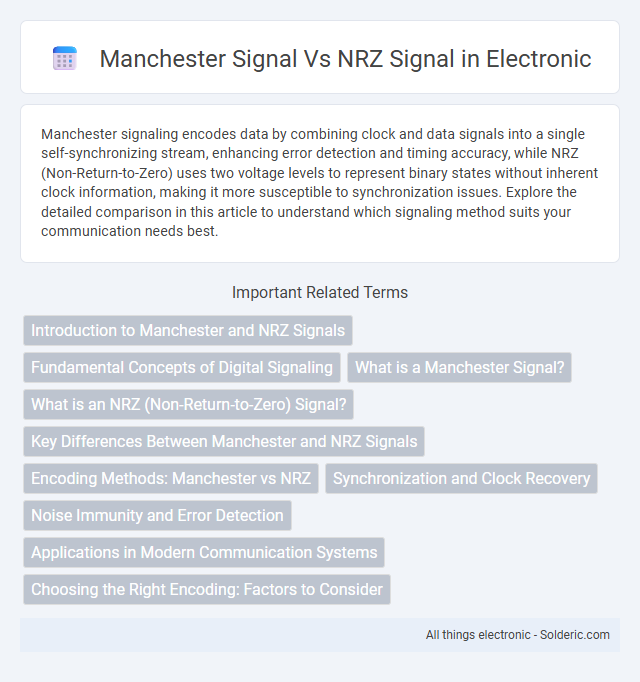Manchester signaling encodes data by combining clock and data signals into a single self-synchronizing stream, enhancing error detection and timing accuracy, while NRZ (Non-Return-to-Zero) uses two voltage levels to represent binary states without inherent clock information, making it more susceptible to synchronization issues. Explore the detailed comparison in this article to understand which signaling method suits your communication needs best.
Comparison Table
| Feature | Manchester Signal | NRZ Signal |
|---|---|---|
| Encoding Type | Self-clocking, phase encoding | Non-return-to-zero, level encoding |
| Signal Transition | Mid-bit transition for clock and data | No guaranteed transition within bits |
| Synchronization | Built-in clock synchronization | Requires external clock recovery |
| Bandwidth Usage | Higher (twice the bit rate) | Lower (equal to bit rate) |
| DC Component | No DC component | Possible DC component |
| Error Detection | Intrinsic due to transitions | Less effective, needs additional methods |
| Application | Ethernet, RFID, and digital communication | Simple data communication, storage devices |
Introduction to Manchester and NRZ Signals
Manchester signal encoding represents data through a transition at the middle of each bit period, ensuring synchronization by combining clock and data signals in one. NRZ (Non-Return-to-Zero) encoding transmits data by maintaining a constant voltage level throughout the bit interval, with high and low levels directly representing binary values. Manchester signals offer robust timing recovery, while NRZ signals are simpler but susceptible to synchronization issues due to the absence of implicit clocking.
Fundamental Concepts of Digital Signaling
Manchester signal encoding combines clock and data signals into a single self-synchronizing stream by representing logical '1' with a high-to-low transition and logical '0' with a low-to-high transition within each bit period. NRZ (Non-Return-to-Zero) signal encodes data by maintaining a constant voltage level throughout the bit interval, with high representing one binary state and low the other, making it simpler but susceptible to synchronization issues. Your understanding of these fundamental digital signaling methods is crucial for selecting the appropriate encoding technique based on timing accuracy and noise immunity requirements in communication systems.
What is a Manchester Signal?
Manchester signal is a digital encoding technique in which each bit of data is represented by a transition at the midpoint of the bit period, combining clock and data information into a single self-synchronizing stream. It uses a voltage transition from low to high or high to low to represent binary values, ensuring synchronization without a separate clock signal. Manchester encoding improves signal integrity and timing accuracy compared to Non-Return-to-Zero (NRZ) signals, making it suitable for network communications.
What is an NRZ (Non-Return-to-Zero) Signal?
An NRZ (Non-Return-to-Zero) signal represents digital data using two distinct voltage levels without returning to a zero voltage between bits, allowing efficient use of bandwidth and simplified decoding in communication systems. Unlike Manchester encoding, which incorporates frequent transitions for synchronization, NRZ signals maintain a steady state, enhancing data transmission speed but potentially causing clock recovery issues. Understanding NRZ is essential for evaluating trade-offs in digital communication techniques and optimizing Your signal integrity requirements.
Key Differences Between Manchester and NRZ Signals
Manchester signal encodes data by combining clock and data information into a single self-synchronizing stream with transitions at the middle of each bit period, providing robust timing recovery. NRZ (Non-Return-to-Zero) signal represents binary data using two voltage levels without inherent clock information, which can lead to synchronization challenges during long sequences of identical bits. Manchester encoding doubles the bandwidth requirement compared to NRZ but offers better error detection and synchronization capabilities in digital communication systems.
Encoding Methods: Manchester vs NRZ
Manchester encoding combines clock and data signals by representing logical '1' with a high-to-low voltage transition and logical '0' with a low-to-high transition within each bit period, enhancing synchronization and error detection. NRZ (Non-Return-to-Zero) encoding represents '1' by a high voltage level and '0' by a low voltage level without transitions during a bit interval, which improves bandwidth efficiency but can lead to synchronization challenges. Your choice between Manchester and NRZ encoding methods depends on the trade-off between robustness in timing recovery and data transmission efficiency.
Synchronization and Clock Recovery
Manchester signals embed clock information within the data stream by using transitions at the middle of each bit period, enabling robust synchronization and clock recovery in noisy environments. NRZ signals lack inherent clock information, requiring separate clock recovery mechanisms such as phase-locked loops, which can complicate synchronization and increase error rates. Your choice between Manchester and NRZ should consider the trade-off between bandwidth efficiency and the reliability of clock recovery in your communication system.
Noise Immunity and Error Detection
Manchester signaling provides superior noise immunity compared to NRZ signals due to its consistent signal transitions, enabling better synchronization and easier detection of signal distortions. This inherent characteristic allows Manchester encoding to facilitate error detection by embedding a clock signal within the data stream, making it straightforward to identify and correct bit errors. Your communication systems benefit from enhanced reliability when using Manchester signaling, especially in noisy environments where NRZ signals are more prone to errors and signal degradation.
Applications in Modern Communication Systems
Manchester signaling is widely used in Ethernet and RFID systems due to its self-clocking feature, ensuring data integrity over noisy channels. NRZ signal is favored in high-speed serial communication like USB and SATA for its simplicity and bandwidth efficiency but requires additional synchronization techniques. Your choice of signaling directly impacts system reliability and data rate performance in modern communication networks.
Choosing the Right Encoding: Factors to Consider
Choosing between Manchester and NRZ signal encoding depends on factors such as bandwidth efficiency, synchronization needs, and noise immunity. Manchester encoding offers inherent clock synchronization and better noise resistance, making it suitable for high-integrity data transmission, while NRZ provides higher bandwidth efficiency but may suffer from synchronization issues. Your decision should weigh the trade-offs between signal clarity and transmission efficiency based on your application's requirements.
Manchester signal vs NRZ signal Infographic

 solderic.com
solderic.com